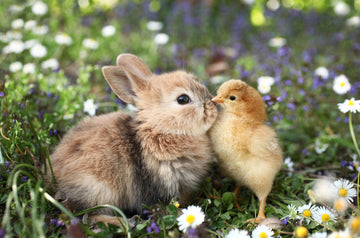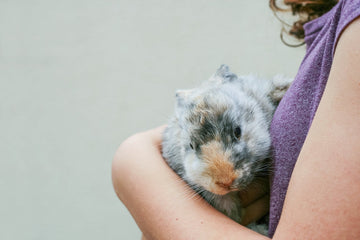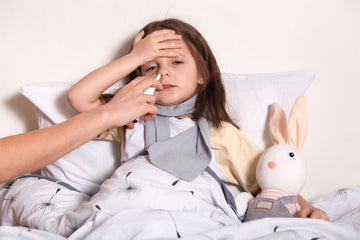RHDV2 - Critical Information & FAQ's [Updated 01/29/2024]
We understand how important it is to keep your rabbits safe and to be informed about the current status of Rabbit Hemorrhagic Disease (RHDV2) and where the outbreaks are occurring as it slowly spreads to different counties across the United States.

Our team at Rabbit Hole Hay continues to receive phone calls and email questions about any precautions we are taking and where we source our hay to see if it's safe for their rabbits.
Before we go any further, we want to reassure our customers that we are keeping a close eye on what is being reported by the California Department of Food & Agriculture (the agency that is monitoring RHDV2 in California) and to date there have been NO reported cases of RHDV2 in the Northern California areas where we source our hay and where our warehouse is located.
RHDV2: What You Need To Know
Rabbit Hemorrhagic Disease (RHDV) is a highly contagious and fatal disease that is caused by a calicivirus and, as the name suggests, affects rabbits. It's a deadly virus that affects both domestic (pet) and wild rabbits. It kills quickly, giving little to no warning.
GOOD NEWS: A safe and effective RHDV2 vaccine is now available. Please consult with your veterinarian and discuss if using the vaccine is the right decision for your rabbits, but the House Rabbit Society highly recommends that all rabbit owners, even fosterers and shelters, get their rabbits vaccinated ASAP.
Read more about the Medgene Labs, the company who developed the vaccine for the prevention of RHDV2, along with a list of the 45 states, including Washington D.C., that are currently able to distribute the vaccine.
RHDV causes necrotizing hepatitis and may cause necrosis of the spleen. There may be internal or external visible blood hemorrhage. Death occurs from liver failure or hemorrhage due to an impairment in the blood's ability to clot. Any sudden death, especially in a rabbit that is otherwise healthy, is to be placed under suspicion and should be reported to your vet as a possible case of RHD.
For more information, please check out House Rabbit Society's page for their RHDV Resource Center.
RHDV2: California Monitoring
The first California case was reported in May of 2020 in Palm Springs (Riverside county), where a jackrabbit died from RHDV2 according to the California Department of Fish and Wildlife. Since May, there have been more cases of both wild and domestic rabbit deaths. Here is the latest from California Department of Food & Agriculture:
"March 2, 2023, 2022 Update – New Detections of Rabbit Hemorrhagic Disease in California
Disease has been detected in domestic and/or wild rabbits in twenty-four California counties - considered endemic in those counties
CDFA taking limited regulatory action
SACRAMENTO, March 2, 2023 – RHDV2 was detected in domestic rabbits in Sacramento County on February 28 and in a wild jackrabbit in Santa Clara County on February 8, 2023. It was previously detected in a wild jackrabbit in Sacramento County in December 2022."
Medgene Labs (Brookings, SD) received Emergency Use authorization from the United States Department of Agriculture’s Center for Veterinary Biologics (CVB) for their experimental vaccine for prevention of Rabbit Hemorrhagic Disease Virus serotype 2 (RHDV2). The new vaccine is a killed recombinant vaccine which is authorized as a two-dose series, with the second dose given 21 days after the first. Rabbit owners should contact their private veterinarian if they are interested in vaccination for RHD. Veterinarians may contact Medgene Labs at info@medgenelabs.com for information about obtaining RHD vaccine."
Click here to view a detailed list of California counties affected domestic vs wild and the date on which it was discovered.
California has executed a quarantine on rabbits entering the state, forbidding rabbits to enter from any state that has been diagnosed with RHDV in the last 12 months. The only exception is if they have a Certificate of Veterinary Inspection.
RHDV2: United States Monitoring
Below you'll find a map of the counties that have been affected by RHDV2 as of January 29, 2024. You'll also find that we highlighted the areas where we've already known about the outbreak (cases) along with the most recent outbreaks as of December 2023. We have also highlighted where our hay is grown at the very top of Northern California. We wanted you to be able to see the physical distance between them.
RHDV2 Map of Affected Counties (Domestic Rabbit Cases Only)
Red Outline = RHDV2 Stable / Endemic Area

2020-2023 RHDV Affected Counties Map Key
Counties filled with a grayish color = domestic rabbit case(s) from Mar 2020 - Dec 31, 2023
- Slate Gray = 4 or more cases
- Sky Blue = 2 -3 cases
- Light Blue/Grey = 1 case
Counties filled with pinkish color = feral domestic rabbit case(s) from Mar 2020 - Dec 31, 2023
- Hot Pink = 5 cases
- Dull Purple/Pink = 1 case
RHDV2 Map of Affected Counties (Wild Rabbit Cases Only)
Red Outline = RHDV2 Stable / Endemic Area

Counties filled with a reddish color = wild rabbit case(s) from Mar 2020 - Dec 31, 2023
- Indian Red = 4 or more cases
- Light Coral = 2 - 3 cases
- Light Pink = 1 case
What is Rabbit Hole Hay Doing to Ensure Your Small Pets Safety?
At Rabbit Hole Hay, we are monitoring this virus closely and at this time it has NOT affected our area of the country (Northern California). While all our hay is from the 2022-2023 growing season from Northern California, there have been NO reported cases affecting the area of the country where we source our hay.
As mentioned above, the USDA estimates that RHDV2 can remain stable for 3 months. Considering the dates of the recently confirmed cases and dates of harvest, we can safely reassure you that no Rabbit Hole Hay product that is available (whether on our website, Amazon, Chewy, Walmart, or by third-party seller) is currently at risk for being a carrier of RHDV2.
Our goal here at Rabbit Hole Hay is to continue to monitor the information coming from health officials carefully to ensure we are following any recommended precautions to keep your small pet safe. We are confident at this time based on the latest available information that the transmission of RHDV2 from a packaged product like our Rabbit Hole Hay, is highly unlikely. While RHDV2 could be transmitted in hay, it would require a rare combination of circumstances for the virus to be present and remain stable.
Even knowing that, we are committed to remaining vigilant both in how we monitor and how we move forward with product safety as it relates to RHDV2. We will be paying close attention to all the hay we source in the coming days and months to ensure it is processed in a way that helps us keep your small pets safe.
What’s the Difference Between RHDV1 and RHDV2?
As stated above, RHDV1 has been around since the 1980s but wasn’t identified in the U.S. until the 2000s only infecting wild rabbits. RHDV2 appeared in France in 2010 and was confirmed in North America in 2018. The biggest difference between the two is that RHDV2 has been confirmed to infect both wild AND domesticated rabbits in North America.
RHDV1 Facts:
- Incubation period: 2-10 Days
- Death Rate is high for rabbits exposed (40-100%)
RHDV2 Facts:
- Incubation period: 3-9 Days
- Death rate is high for rabbits exposed (5-80%)
Rabbits who are exposed and survive, are carriers and can spread the virus for a minimum of 42 days, if not longer. The California Department of Food & Agriculture has provided this information sheet about RHDV that also contains ways you can help protect your rabbits that you can download and print.
How Does RHDV2 Spread?
The USDA states that the RHDV2 virus is very resistant to extreme temperatures, it can be spread through direct contact or exposure to an infected rabbit’s excretions or blood. The virus can also survive and spread from carcasses, food, water, and any contaminated materials. While it does not impact human health, humans can spread the virus indirectly by carrying it on their clothing and shoes.
What are the Symptoms to Look For?
According to House Rabbit Society, rabbits can contract the virus and not show any symptoms whatsoever. But with those that do show symptoms, they may include:
- Loss of appetite
- Lethargy
- High fever
- Seizures
- Bleeding from nose, mouth, or rectum
- Difficulty breathing
- Sudden death
Sadly, this virus is known as a swift and sudden killer with little to no warning. If your rabbit’s sudden death is suspicious, please report it to your veterinarian as a possible case of RHDV2.
Is there a RHDV2 Vaccine?
Vaccines for RHDV2 are generally available in countries where the disease is regularly found (called endemic).
Previously there was only a RHDV2 vaccine in Europe as it has been regularly found there for a longer period of time. But, as of September 27, 2021 a new U.S. vaccine has received emergency use authorization.
The California Department of Food & Agriculture stated:
"SACRAMENTO, March 2, 2023 – Medgene Labs (Brookings, SD) received Emergency Use authorization from the United States Department of Agriculture’s Center for Veterinary Biologics (CVB) for their experimental vaccine for prevention of Rabbit Hemorrhagic Disease Virus serotype 2 (RHDV2). The new vaccine is a killed recombinant vaccine which is authorized as a two-dose series, with the second dose given 21 days after the first. Rabbit owners should contact their private veterinarian if they are interested in vaccination for RHD. Veterinarians may contact Medgene Labs at info@medgenelabs.com for information about obtaining RHD vaccine."
Click here to view a detailed list of California counties affected domestic vs wild and the date on which it was discovered.
Read more about the Medgene Labs, the company who developed the vaccine for the prevention of RHDV2, along with a list of the 45 states, including Washington D.C., that are currently able to distribute the vaccine.
You can also read through the House Rabbit Society's FAQ on the vaccine.
It's important that you consult your veterinarian and discuss if using the vaccine is the right decision for your rabbit(s).
How Long Can RHDV2 Survive in the Environment?
While the statements on how long it can stay within the environment are mixed, the USDA has stated, “The virus can remain stable for 3 months when dried, but exposed RHDV typically doesn’t persist in excretions on surroundings longer than a few weeks and grows less viable over time.”
Should I Be Worried that the Hay I Purchase Could Give My Rabbit RHDV2?
The risk is very low of your rabbits contracting the RHDV2 from the hay you purchase from a trusted producer.
While RHDV2 can be transmitted via non-living objects (known as fomite) like hay, it would require a combination of unique events to occur for hay to become a carrier. This includes an infected animal traveling through the hay field during a time when specific environmental conditions are in place which supported the stability of the virus.
It is also important to note that when you purchase from a trusted manufacturer, there are quality and safety measures in place that will help mitigate the risk of transmission.
How Can You Protect Your Rabbit?
- Keep your rabbit’s cage or hutch indoors, decreasing the risk of them coming into contact with something outdoors.
- If you can’t keep your rabbit’s hutch or cage indoors, invest in protective fencing and continue to monitor them for any disturbances.
- When it comes to the inside and outside of your rabbit’s cage or hutch, practice good cleaning and sanitation measures.
- Remember to wash your hands thoroughly before handling your rabbits.
- Immediately after handling or coming in contact with other rabbits, change your clothes and wash your hands.
- Refrain from having bunny time with other rabbits, this will keep your rabbit safe from the possibility of coming into to physical contact with other rabbits.
- Don’t touch any dead wild rabbits that you may see in your local area. If you see multiple dead rabbits, report it to your state wildlife officials.
- If you volunteer at a shelter in an area with an outbreak, have special clothes and shoes you wear only when working at the shelter.
- Consider adopting a “no shoes” in the house policy.
For statements regarding RHDV vaccinations and biosecurity measures by state, click here.
Looking to join a community of rabbit owners dedicated to watching RHDV2 and see more up-to-date information on a case by case basis? Join the Rabbit Hemorrhagic Disease News Network on Facebook.

Can Rabbits and Chickens Live Together Safely?

Keeping Your Rabbit Safe

Are Rabbits Hypoallergenic?










